TAFE NSW CHCPRT001 Project: Child Risk and Protection Assessment
VerifiedAdded on 2023/06/07
|24
|5669
|231
Project
AI Summary
This project assessment, for the TAFE NSW CHCPRT001 unit, evaluates the student's ability to identify and respond to children and young people at risk. The assessment is divided into three parts: scenarios, Risk of Significant Harm (RoSH) reports, and short answer questions. Students are required to analyze scenarios, identify ethical concerns, and complete RoSH reports based on either early childhood or school-based situations. The project emphasizes the application of legislative and policy frameworks, and the demonstration of a duty of care. The assessment also includes an assessment checklist, feedback, and an appendix for the RoSH report, ensuring a comprehensive evaluation of the student's understanding and practical skills in child protection.
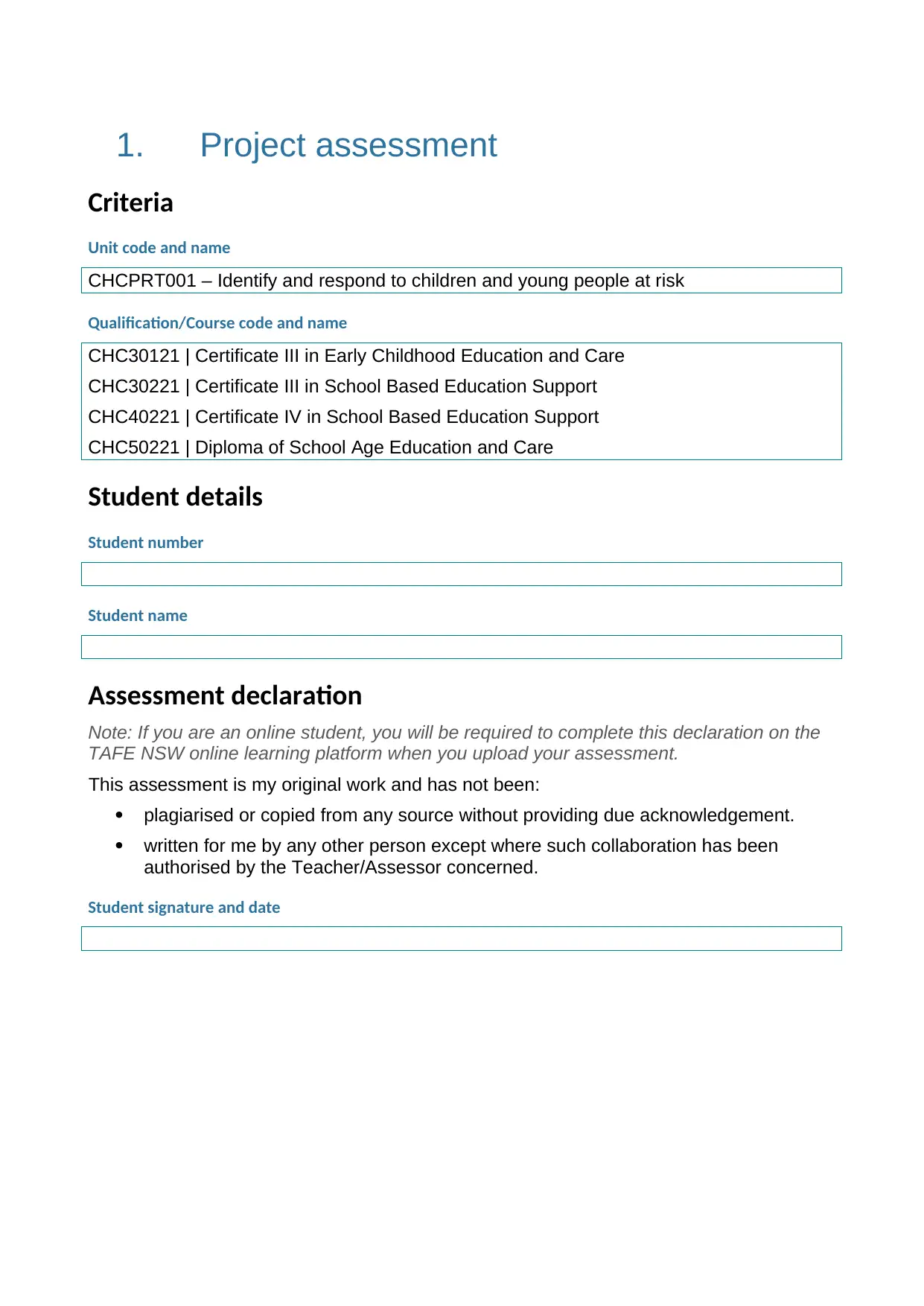
1. Project assessment
Criteria
Unit code and name
CHCPRT001 – Identify and respond to children and young people at risk
Qualification/Course code and name
CHC30121 | Certificate III in Early Childhood Education and Care
CHC30221 | Certificate III in School Based Education Support
CHC40221 | Certificate IV in School Based Education Support
CHC50221 | Diploma of School Age Education and Care
Student details
Student number
Student name
Assessment declaration
Note: If you are an online student, you will be required to complete this declaration on the
TAFE NSW online learning platform when you upload your assessment.
This assessment is my original work and has not been:
plagiarised or copied from any source without providing due acknowledgement.
written for me by any other person except where such collaboration has been
authorised by the Teacher/Assessor concerned.
Student signature and date
Criteria
Unit code and name
CHCPRT001 – Identify and respond to children and young people at risk
Qualification/Course code and name
CHC30121 | Certificate III in Early Childhood Education and Care
CHC30221 | Certificate III in School Based Education Support
CHC40221 | Certificate IV in School Based Education Support
CHC50221 | Diploma of School Age Education and Care
Student details
Student number
Student name
Assessment declaration
Note: If you are an online student, you will be required to complete this declaration on the
TAFE NSW online learning platform when you upload your assessment.
This assessment is my original work and has not been:
plagiarised or copied from any source without providing due acknowledgement.
written for me by any other person except where such collaboration has been
authorised by the Teacher/Assessor concerned.
Student signature and date
Paraphrase This Document
Need a fresh take? Get an instant paraphrase of this document with our AI Paraphraser

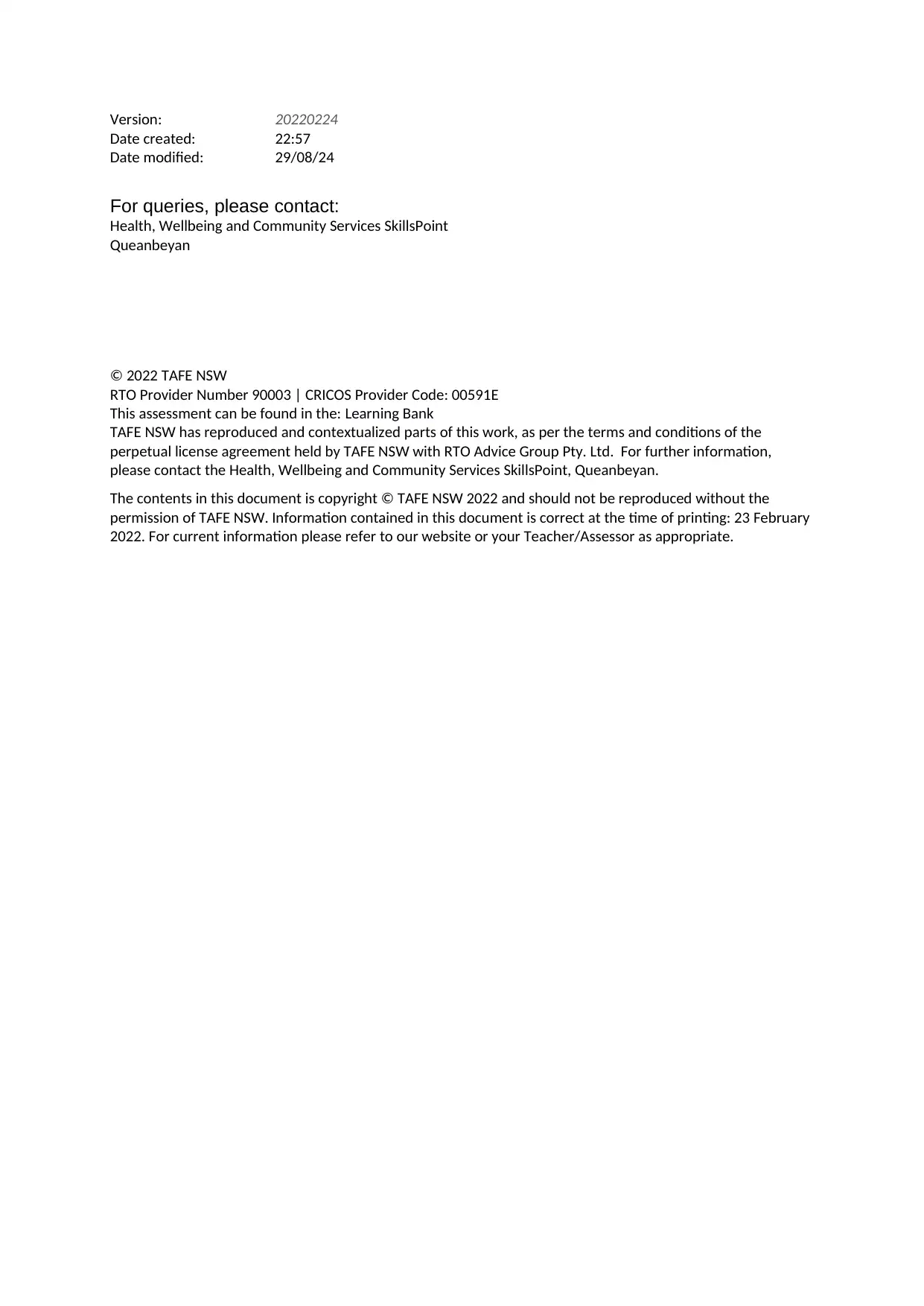
Version: 20220224
Date created: 22:57
Date modified: 29/08/24
For queries, please contact:
Health, Wellbeing and Community Services SkillsPoint
Queanbeyan
© 2022 TAFE NSW
RTO Provider Number 90003 | CRICOS Provider Code: 00591E
This assessment can be found in the: Learning Bank
TAFE NSW has reproduced and contextualized parts of this work, as per the terms and conditions of the
perpetual license agreement held by TAFE NSW with RTO Advice Group Pty. Ltd. For further information,
please contact the Health, Wellbeing and Community Services SkillsPoint, Queanbeyan.
The contents in this document is copyright © TAFE NSW 2022 and should not be reproduced without the
permission of TAFE NSW. Information contained in this document is correct at the time of printing: 23 February
2022. For current information please refer to our website or your Teacher/Assessor as appropriate.
Date created: 22:57
Date modified: 29/08/24
For queries, please contact:
Health, Wellbeing and Community Services SkillsPoint
Queanbeyan
© 2022 TAFE NSW
RTO Provider Number 90003 | CRICOS Provider Code: 00591E
This assessment can be found in the: Learning Bank
TAFE NSW has reproduced and contextualized parts of this work, as per the terms and conditions of the
perpetual license agreement held by TAFE NSW with RTO Advice Group Pty. Ltd. For further information,
please contact the Health, Wellbeing and Community Services SkillsPoint, Queanbeyan.
The contents in this document is copyright © TAFE NSW 2022 and should not be reproduced without the
permission of TAFE NSW. Information contained in this document is correct at the time of printing: 23 February
2022. For current information please refer to our website or your Teacher/Assessor as appropriate.
⊘ This is a preview!⊘
Do you want full access?
Subscribe today to unlock all pages.

Trusted by 1+ million students worldwide
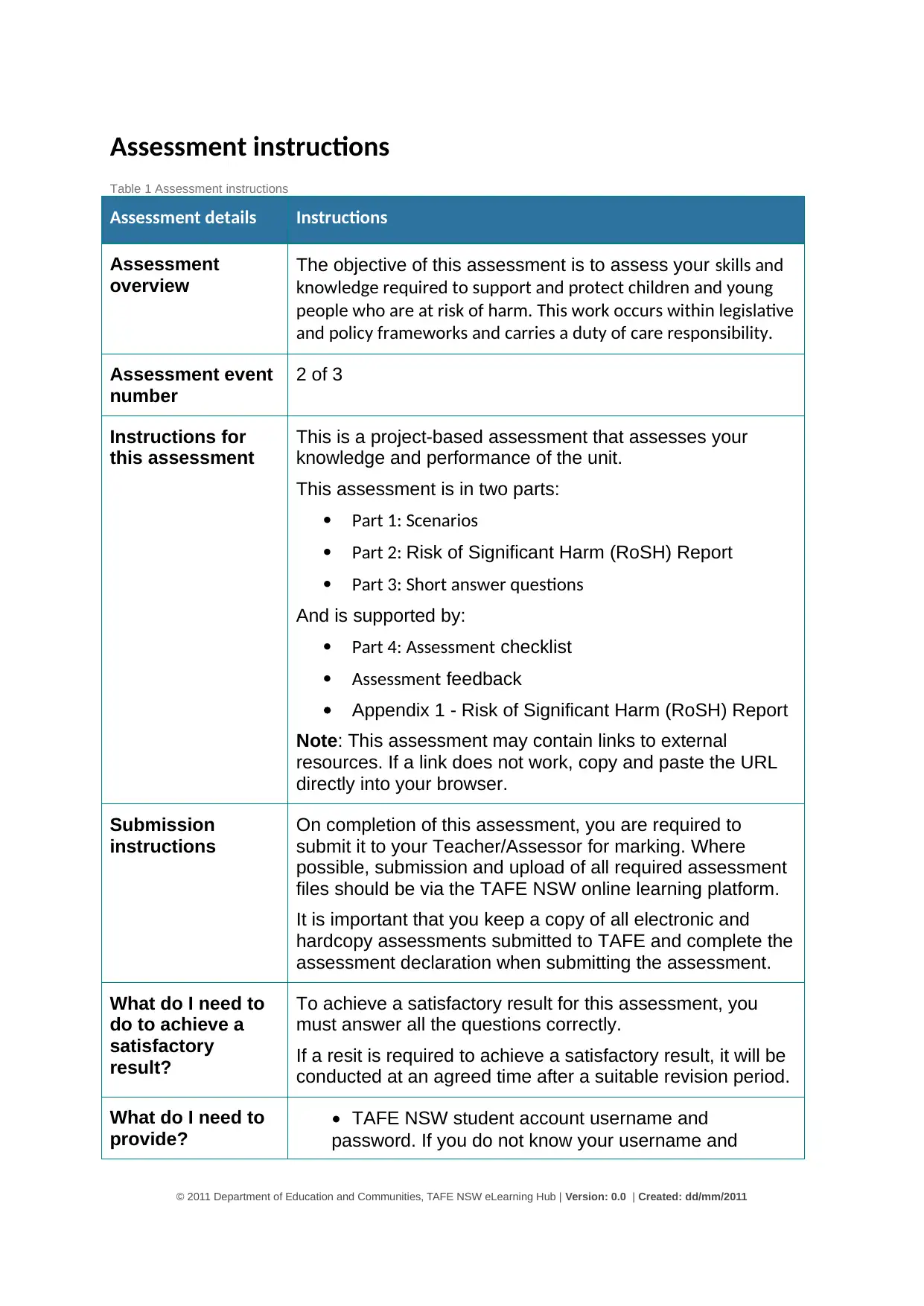
Assessment instructions
Table 1 Assessment instructions
Assessment details Instructions
Assessment
overview
The objective of this assessment is to assess your skills and
knowledge required to support and protect children and young
people who are at risk of harm. This work occurs within legislative
and policy frameworks and carries a duty of care responsibility.
Assessment event
number
2 of 3
Instructions for
this assessment
This is a project-based assessment that assesses your
knowledge and performance of the unit.
This assessment is in two parts:
Part 1: Scenarios
Part 2: Risk of Significant Harm (RoSH) Report
Part 3: Short answer questions
And is supported by:
Part 4: Assessment checklist
Assessment feedback
Appendix 1 - Risk of Significant Harm (RoSH) Report
Note: This assessment may contain links to external
resources. If a link does not work, copy and paste the URL
directly into your browser.
Submission
instructions
On completion of this assessment, you are required to
submit it to your Teacher/Assessor for marking. Where
possible, submission and upload of all required assessment
files should be via the TAFE NSW online learning platform.
It is important that you keep a copy of all electronic and
hardcopy assessments submitted to TAFE and complete the
assessment declaration when submitting the assessment.
What do I need to
do to achieve a
satisfactory
result?
To achieve a satisfactory result for this assessment, you
must answer all the questions correctly.
If a resit is required to achieve a satisfactory result, it will be
conducted at an agreed time after a suitable revision period.
What do I need to
provide?
• TAFE NSW student account username and
password. If you do not know your username and
© 2011 Department of Education and Communities, TAFE NSW eLearning Hub | Version: 0.0 | Created: dd/mm/2011
Table 1 Assessment instructions
Assessment details Instructions
Assessment
overview
The objective of this assessment is to assess your skills and
knowledge required to support and protect children and young
people who are at risk of harm. This work occurs within legislative
and policy frameworks and carries a duty of care responsibility.
Assessment event
number
2 of 3
Instructions for
this assessment
This is a project-based assessment that assesses your
knowledge and performance of the unit.
This assessment is in two parts:
Part 1: Scenarios
Part 2: Risk of Significant Harm (RoSH) Report
Part 3: Short answer questions
And is supported by:
Part 4: Assessment checklist
Assessment feedback
Appendix 1 - Risk of Significant Harm (RoSH) Report
Note: This assessment may contain links to external
resources. If a link does not work, copy and paste the URL
directly into your browser.
Submission
instructions
On completion of this assessment, you are required to
submit it to your Teacher/Assessor for marking. Where
possible, submission and upload of all required assessment
files should be via the TAFE NSW online learning platform.
It is important that you keep a copy of all electronic and
hardcopy assessments submitted to TAFE and complete the
assessment declaration when submitting the assessment.
What do I need to
do to achieve a
satisfactory
result?
To achieve a satisfactory result for this assessment, you
must answer all the questions correctly.
If a resit is required to achieve a satisfactory result, it will be
conducted at an agreed time after a suitable revision period.
What do I need to
provide?
• TAFE NSW student account username and
password. If you do not know your username and
© 2011 Department of Education and Communities, TAFE NSW eLearning Hub | Version: 0.0 | Created: dd/mm/2011
Paraphrase This Document
Need a fresh take? Get an instant paraphrase of this document with our AI Paraphraser
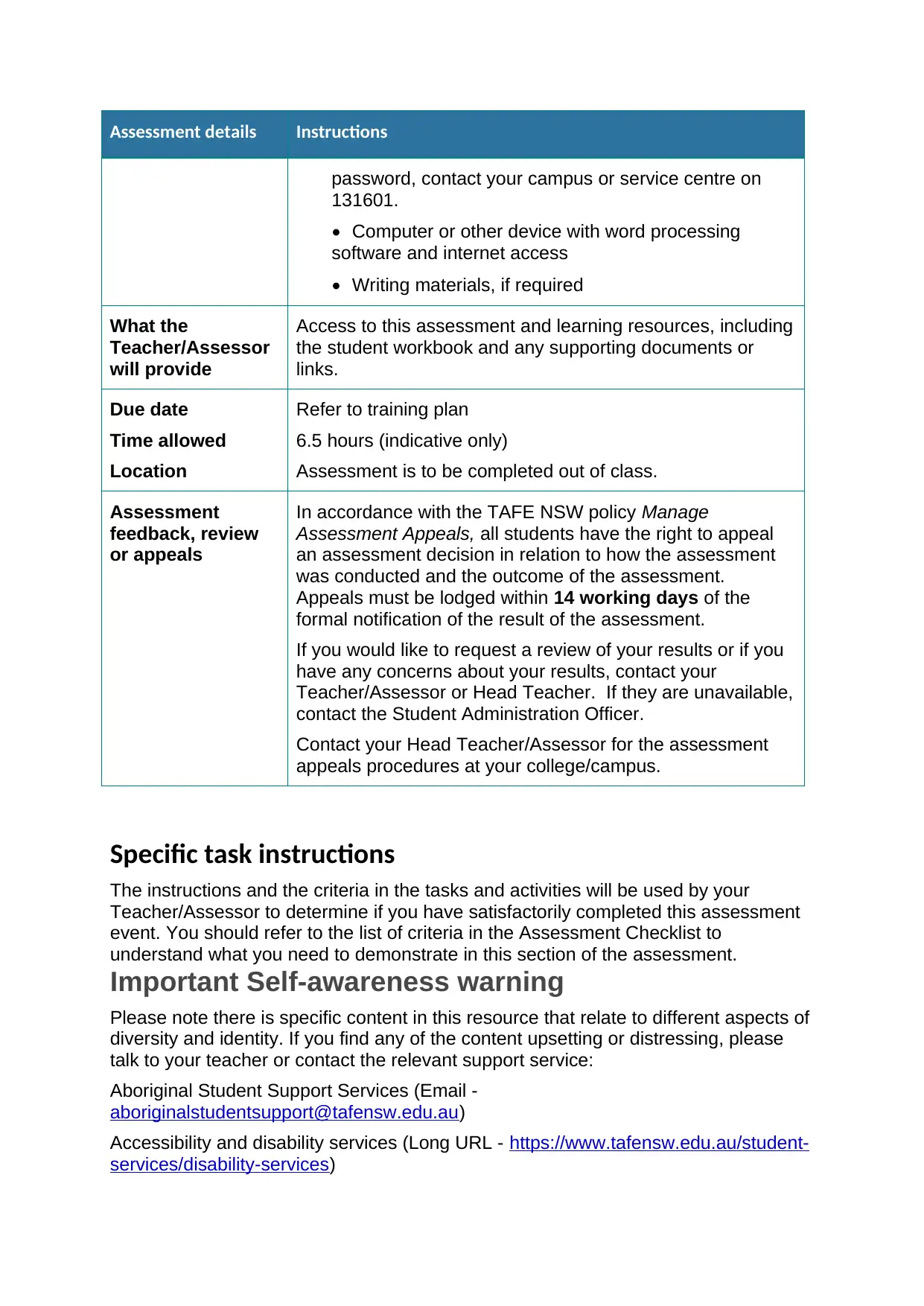
Assessment details Instructions
password, contact your campus or service centre on
131601.
• Computer or other device with word processing
software and internet access
• Writing materials, if required
What the
Teacher/Assessor
will provide
Access to this assessment and learning resources, including
the student workbook and any supporting documents or
links.
Due date
Time allowed
Location
Refer to training plan
6.5 hours (indicative only)
Assessment is to be completed out of class.
Assessment
feedback, review
or appeals
In accordance with the TAFE NSW policy Manage
Assessment Appeals, all students have the right to appeal
an assessment decision in relation to how the assessment
was conducted and the outcome of the assessment.
Appeals must be lodged within 14 working days of the
formal notification of the result of the assessment.
If you would like to request a review of your results or if you
have any concerns about your results, contact your
Teacher/Assessor or Head Teacher. If they are unavailable,
contact the Student Administration Officer.
Contact your Head Teacher/Assessor for the assessment
appeals procedures at your college/campus.
Specific task instructions
The instructions and the criteria in the tasks and activities will be used by your
Teacher/Assessor to determine if you have satisfactorily completed this assessment
event. You should refer to the list of criteria in the Assessment Checklist to
understand what you need to demonstrate in this section of the assessment.
Important Self-awareness warning
Please note there is specific content in this resource that relate to different aspects of
diversity and identity. If you find any of the content upsetting or distressing, please
talk to your teacher or contact the relevant support service:
Aboriginal Student Support Services (Email -
aboriginalstudentsupport@tafensw.edu.au)
Accessibility and disability services (Long URL - https://www.tafensw.edu.au/student-
services/disability-services)
password, contact your campus or service centre on
131601.
• Computer or other device with word processing
software and internet access
• Writing materials, if required
What the
Teacher/Assessor
will provide
Access to this assessment and learning resources, including
the student workbook and any supporting documents or
links.
Due date
Time allowed
Location
Refer to training plan
6.5 hours (indicative only)
Assessment is to be completed out of class.
Assessment
feedback, review
or appeals
In accordance with the TAFE NSW policy Manage
Assessment Appeals, all students have the right to appeal
an assessment decision in relation to how the assessment
was conducted and the outcome of the assessment.
Appeals must be lodged within 14 working days of the
formal notification of the result of the assessment.
If you would like to request a review of your results or if you
have any concerns about your results, contact your
Teacher/Assessor or Head Teacher. If they are unavailable,
contact the Student Administration Officer.
Contact your Head Teacher/Assessor for the assessment
appeals procedures at your college/campus.
Specific task instructions
The instructions and the criteria in the tasks and activities will be used by your
Teacher/Assessor to determine if you have satisfactorily completed this assessment
event. You should refer to the list of criteria in the Assessment Checklist to
understand what you need to demonstrate in this section of the assessment.
Important Self-awareness warning
Please note there is specific content in this resource that relate to different aspects of
diversity and identity. If you find any of the content upsetting or distressing, please
talk to your teacher or contact the relevant support service:
Aboriginal Student Support Services (Email -
aboriginalstudentsupport@tafensw.edu.au)
Accessibility and disability services (Long URL - https://www.tafensw.edu.au/student-
services/disability-services)
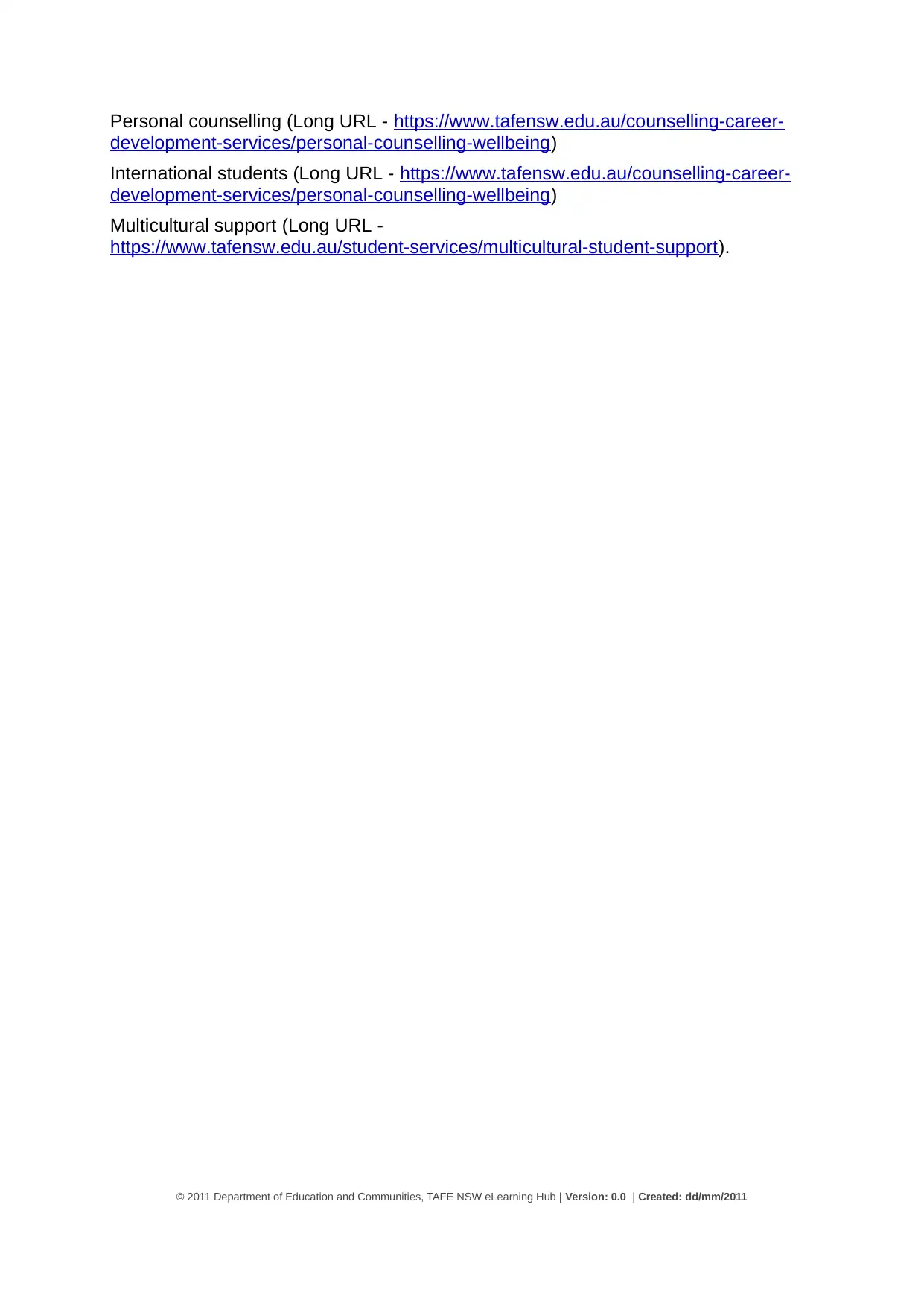
Personal counselling (Long URL - https://www.tafensw.edu.au/counselling-career-
development-services/personal-counselling-wellbeing)
International students (Long URL - https://www.tafensw.edu.au/counselling-career-
development-services/personal-counselling-wellbeing)
Multicultural support (Long URL -
https://www.tafensw.edu.au/student-services/multicultural-student-support).
© 2011 Department of Education and Communities, TAFE NSW eLearning Hub | Version: 0.0 | Created: dd/mm/2011
development-services/personal-counselling-wellbeing)
International students (Long URL - https://www.tafensw.edu.au/counselling-career-
development-services/personal-counselling-wellbeing)
Multicultural support (Long URL -
https://www.tafensw.edu.au/student-services/multicultural-student-support).
© 2011 Department of Education and Communities, TAFE NSW eLearning Hub | Version: 0.0 | Created: dd/mm/2011
⊘ This is a preview!⊘
Do you want full access?
Subscribe today to unlock all pages.

Trusted by 1+ million students worldwide
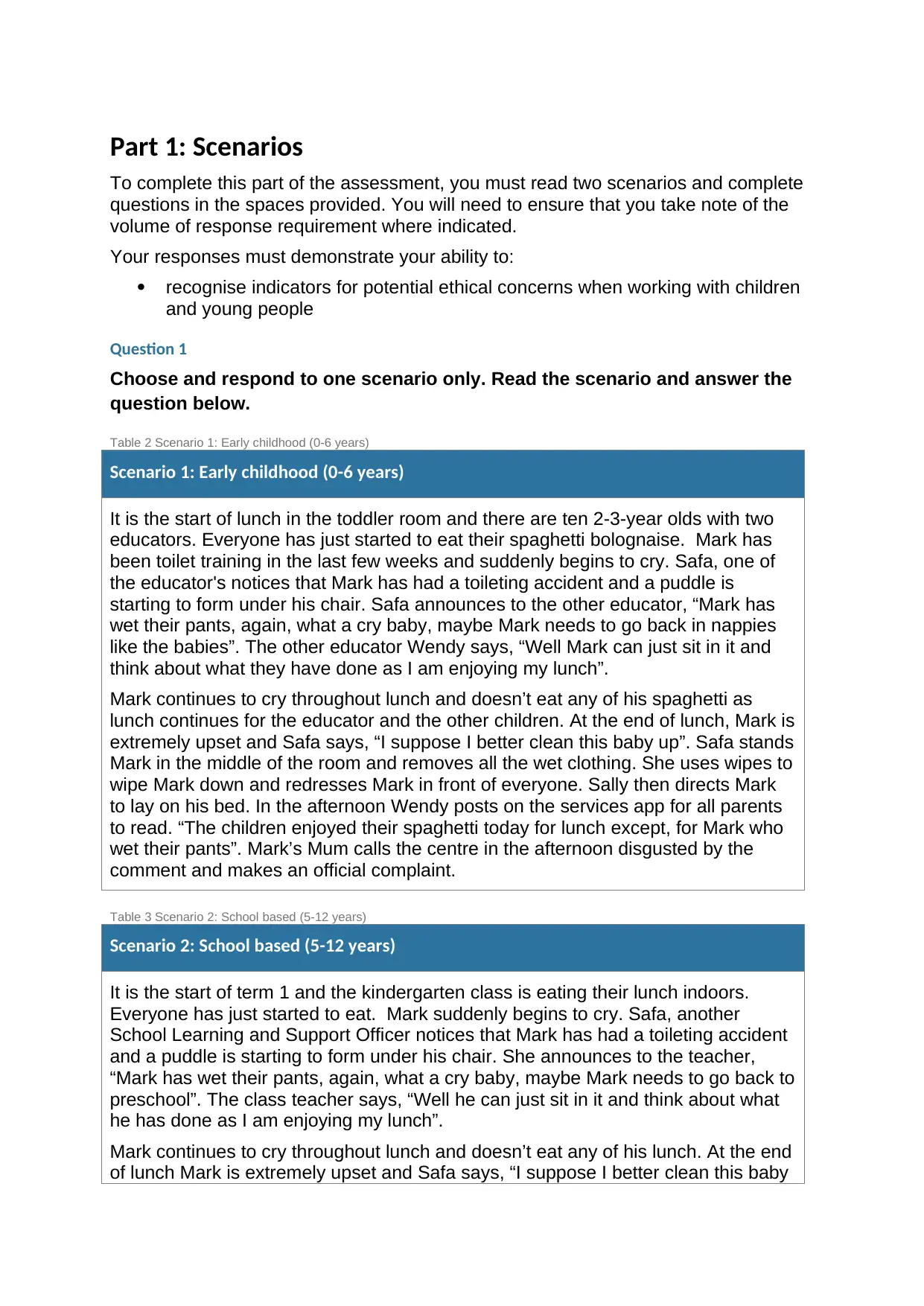
Part 1: Scenarios
To complete this part of the assessment, you must read two scenarios and complete
questions in the spaces provided. You will need to ensure that you take note of the
volume of response requirement where indicated.
Your responses must demonstrate your ability to:
recognise indicators for potential ethical concerns when working with children
and young people
Question 1
Choose and respond to one scenario only. Read the scenario and answer the
question below.
Table 2 Scenario 1: Early childhood (0-6 years)
Scenario 1: Early childhood (0-6 years)
It is the start of lunch in the toddler room and there are ten 2-3-year olds with two
educators. Everyone has just started to eat their spaghetti bolognaise. Mark has
been toilet training in the last few weeks and suddenly begins to cry. Safa, one of
the educator's notices that Mark has had a toileting accident and a puddle is
starting to form under his chair. Safa announces to the other educator, “Mark has
wet their pants, again, what a cry baby, maybe Mark needs to go back in nappies
like the babies”. The other educator Wendy says, “Well Mark can just sit in it and
think about what they have done as I am enjoying my lunch”.
Mark continues to cry throughout lunch and doesn’t eat any of his spaghetti as
lunch continues for the educator and the other children. At the end of lunch, Mark is
extremely upset and Safa says, “I suppose I better clean this baby up”. Safa stands
Mark in the middle of the room and removes all the wet clothing. She uses wipes to
wipe Mark down and redresses Mark in front of everyone. Sally then directs Mark
to lay on his bed. In the afternoon Wendy posts on the services app for all parents
to read. “The children enjoyed their spaghetti today for lunch except, for Mark who
wet their pants”. Mark’s Mum calls the centre in the afternoon disgusted by the
comment and makes an official complaint.
Table 3 Scenario 2: School based (5-12 years)
Scenario 2: School based (5-12 years)
It is the start of term 1 and the kindergarten class is eating their lunch indoors.
Everyone has just started to eat. Mark suddenly begins to cry. Safa, another
School Learning and Support Officer notices that Mark has had a toileting accident
and a puddle is starting to form under his chair. She announces to the teacher,
“Mark has wet their pants, again, what a cry baby, maybe Mark needs to go back to
preschool”. The class teacher says, “Well he can just sit in it and think about what
he has done as I am enjoying my lunch”.
Mark continues to cry throughout lunch and doesn’t eat any of his lunch. At the end
of lunch Mark is extremely upset and Safa says, “I suppose I better clean this baby
To complete this part of the assessment, you must read two scenarios and complete
questions in the spaces provided. You will need to ensure that you take note of the
volume of response requirement where indicated.
Your responses must demonstrate your ability to:
recognise indicators for potential ethical concerns when working with children
and young people
Question 1
Choose and respond to one scenario only. Read the scenario and answer the
question below.
Table 2 Scenario 1: Early childhood (0-6 years)
Scenario 1: Early childhood (0-6 years)
It is the start of lunch in the toddler room and there are ten 2-3-year olds with two
educators. Everyone has just started to eat their spaghetti bolognaise. Mark has
been toilet training in the last few weeks and suddenly begins to cry. Safa, one of
the educator's notices that Mark has had a toileting accident and a puddle is
starting to form under his chair. Safa announces to the other educator, “Mark has
wet their pants, again, what a cry baby, maybe Mark needs to go back in nappies
like the babies”. The other educator Wendy says, “Well Mark can just sit in it and
think about what they have done as I am enjoying my lunch”.
Mark continues to cry throughout lunch and doesn’t eat any of his spaghetti as
lunch continues for the educator and the other children. At the end of lunch, Mark is
extremely upset and Safa says, “I suppose I better clean this baby up”. Safa stands
Mark in the middle of the room and removes all the wet clothing. She uses wipes to
wipe Mark down and redresses Mark in front of everyone. Sally then directs Mark
to lay on his bed. In the afternoon Wendy posts on the services app for all parents
to read. “The children enjoyed their spaghetti today for lunch except, for Mark who
wet their pants”. Mark’s Mum calls the centre in the afternoon disgusted by the
comment and makes an official complaint.
Table 3 Scenario 2: School based (5-12 years)
Scenario 2: School based (5-12 years)
It is the start of term 1 and the kindergarten class is eating their lunch indoors.
Everyone has just started to eat. Mark suddenly begins to cry. Safa, another
School Learning and Support Officer notices that Mark has had a toileting accident
and a puddle is starting to form under his chair. She announces to the teacher,
“Mark has wet their pants, again, what a cry baby, maybe Mark needs to go back to
preschool”. The class teacher says, “Well he can just sit in it and think about what
he has done as I am enjoying my lunch”.
Mark continues to cry throughout lunch and doesn’t eat any of his lunch. At the end
of lunch Mark is extremely upset and Safa says, “I suppose I better clean this baby
Paraphrase This Document
Need a fresh take? Get an instant paraphrase of this document with our AI Paraphraser
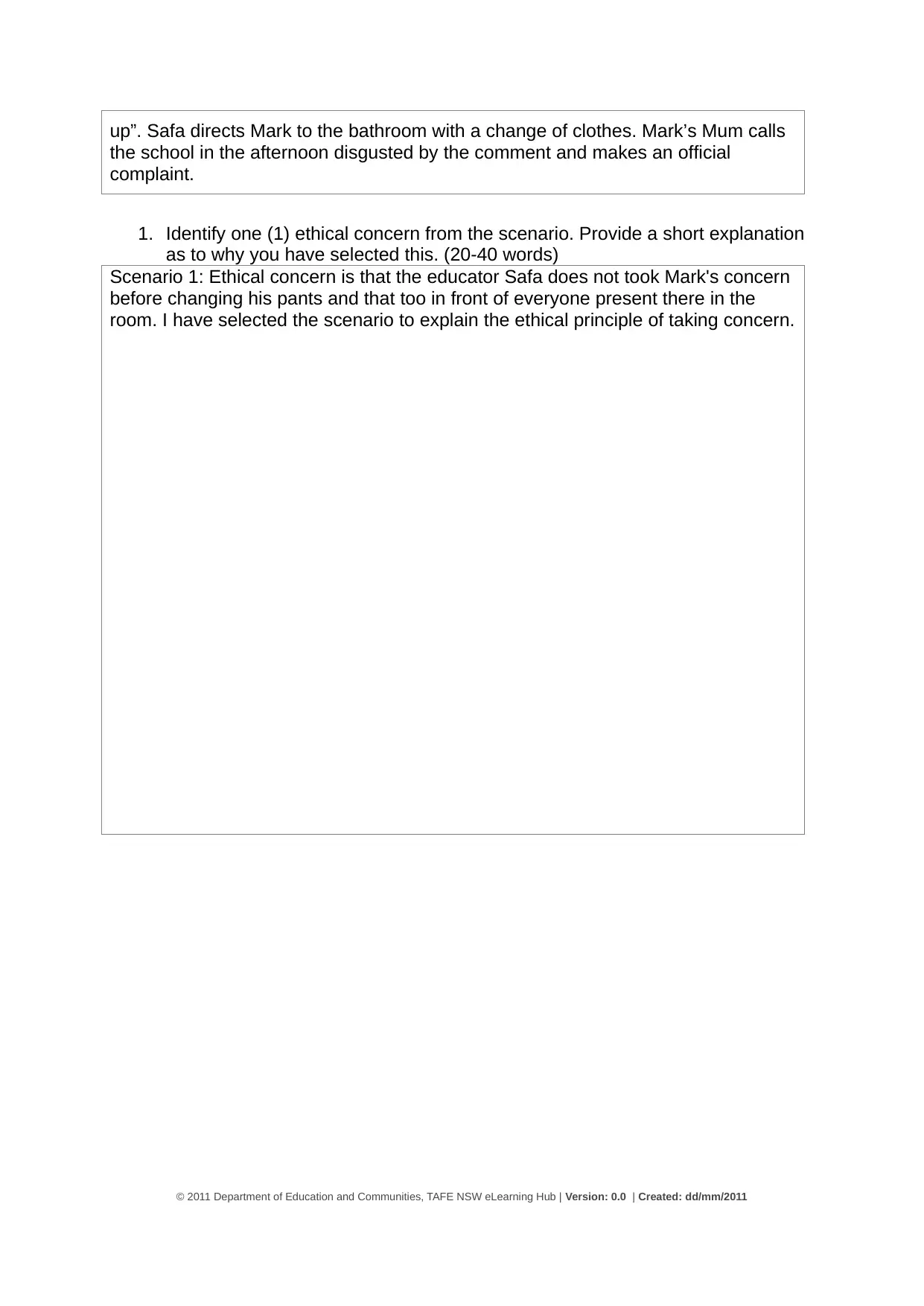
up”. Safa directs Mark to the bathroom with a change of clothes. Mark’s Mum calls
the school in the afternoon disgusted by the comment and makes an official
complaint.
1. Identify one (1) ethical concern from the scenario. Provide a short explanation
as to why you have selected this. (20-40 words)
Scenario 1: Ethical concern is that the educator Safa does not took Mark's concern
before changing his pants and that too in front of everyone present there in the
room. I have selected the scenario to explain the ethical principle of taking concern.
© 2011 Department of Education and Communities, TAFE NSW eLearning Hub | Version: 0.0 | Created: dd/mm/2011
the school in the afternoon disgusted by the comment and makes an official
complaint.
1. Identify one (1) ethical concern from the scenario. Provide a short explanation
as to why you have selected this. (20-40 words)
Scenario 1: Ethical concern is that the educator Safa does not took Mark's concern
before changing his pants and that too in front of everyone present there in the
room. I have selected the scenario to explain the ethical principle of taking concern.
© 2011 Department of Education and Communities, TAFE NSW eLearning Hub | Version: 0.0 | Created: dd/mm/2011
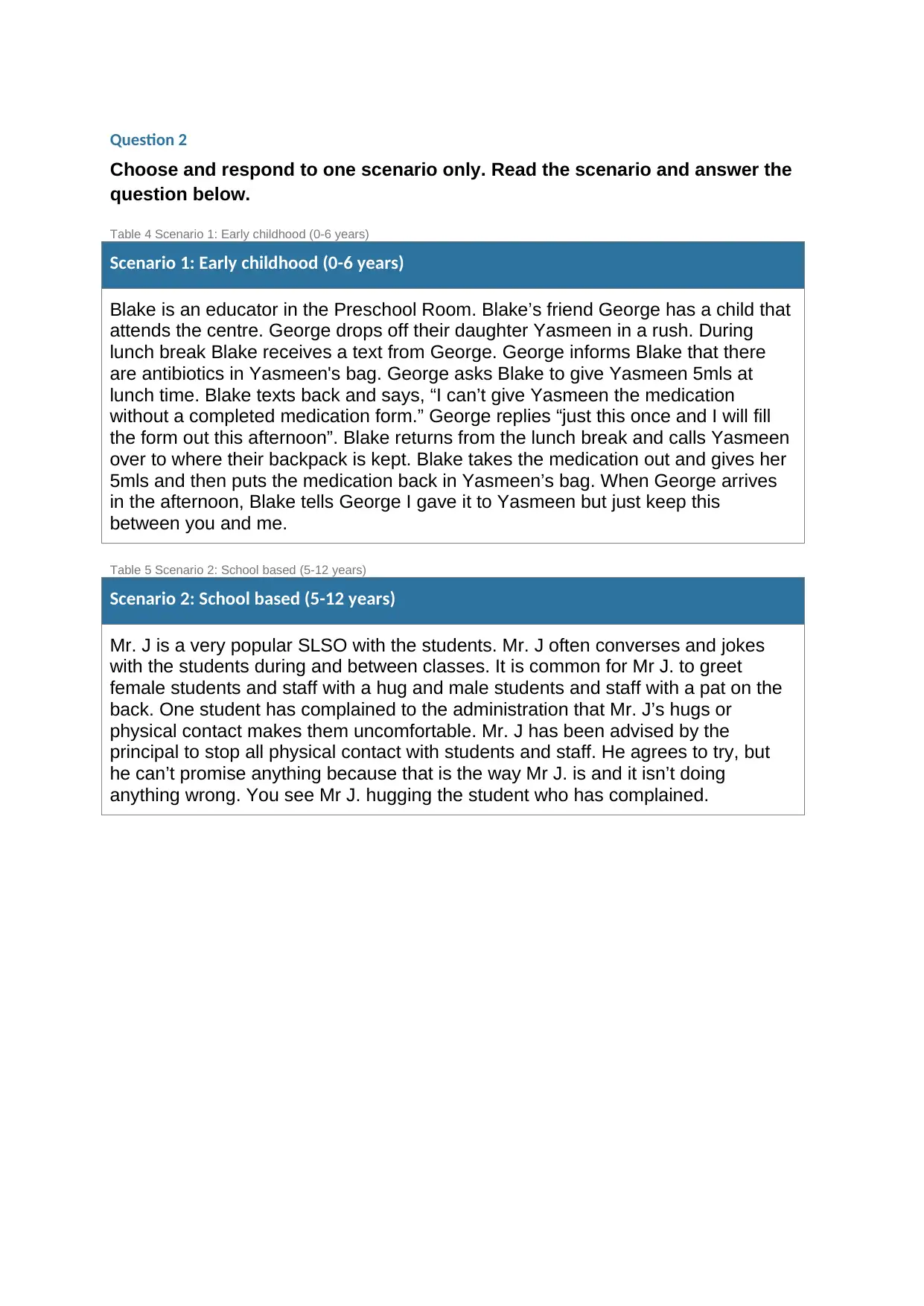
Question 2
Choose and respond to one scenario only. Read the scenario and answer the
question below.
Table 4 Scenario 1: Early childhood (0-6 years)
Scenario 1: Early childhood (0-6 years)
Blake is an educator in the Preschool Room. Blake’s friend George has a child that
attends the centre. George drops off their daughter Yasmeen in a rush. During
lunch break Blake receives a text from George. George informs Blake that there
are antibiotics in Yasmeen's bag. George asks Blake to give Yasmeen 5mls at
lunch time. Blake texts back and says, “I can’t give Yasmeen the medication
without a completed medication form.” George replies “just this once and I will fill
the form out this afternoon”. Blake returns from the lunch break and calls Yasmeen
over to where their backpack is kept. Blake takes the medication out and gives her
5mls and then puts the medication back in Yasmeen’s bag. When George arrives
in the afternoon, Blake tells George I gave it to Yasmeen but just keep this
between you and me.
Table 5 Scenario 2: School based (5-12 years)
Scenario 2: School based (5-12 years)
Mr. J is a very popular SLSO with the students. Mr. J often converses and jokes
with the students during and between classes. It is common for Mr J. to greet
female students and staff with a hug and male students and staff with a pat on the
back. One student has complained to the administration that Mr. J’s hugs or
physical contact makes them uncomfortable. Mr. J has been advised by the
principal to stop all physical contact with students and staff. He agrees to try, but
he can’t promise anything because that is the way Mr J. is and it isn’t doing
anything wrong. You see Mr J. hugging the student who has complained.
Choose and respond to one scenario only. Read the scenario and answer the
question below.
Table 4 Scenario 1: Early childhood (0-6 years)
Scenario 1: Early childhood (0-6 years)
Blake is an educator in the Preschool Room. Blake’s friend George has a child that
attends the centre. George drops off their daughter Yasmeen in a rush. During
lunch break Blake receives a text from George. George informs Blake that there
are antibiotics in Yasmeen's bag. George asks Blake to give Yasmeen 5mls at
lunch time. Blake texts back and says, “I can’t give Yasmeen the medication
without a completed medication form.” George replies “just this once and I will fill
the form out this afternoon”. Blake returns from the lunch break and calls Yasmeen
over to where their backpack is kept. Blake takes the medication out and gives her
5mls and then puts the medication back in Yasmeen’s bag. When George arrives
in the afternoon, Blake tells George I gave it to Yasmeen but just keep this
between you and me.
Table 5 Scenario 2: School based (5-12 years)
Scenario 2: School based (5-12 years)
Mr. J is a very popular SLSO with the students. Mr. J often converses and jokes
with the students during and between classes. It is common for Mr J. to greet
female students and staff with a hug and male students and staff with a pat on the
back. One student has complained to the administration that Mr. J’s hugs or
physical contact makes them uncomfortable. Mr. J has been advised by the
principal to stop all physical contact with students and staff. He agrees to try, but
he can’t promise anything because that is the way Mr J. is and it isn’t doing
anything wrong. You see Mr J. hugging the student who has complained.
⊘ This is a preview!⊘
Do you want full access?
Subscribe today to unlock all pages.

Trusted by 1+ million students worldwide
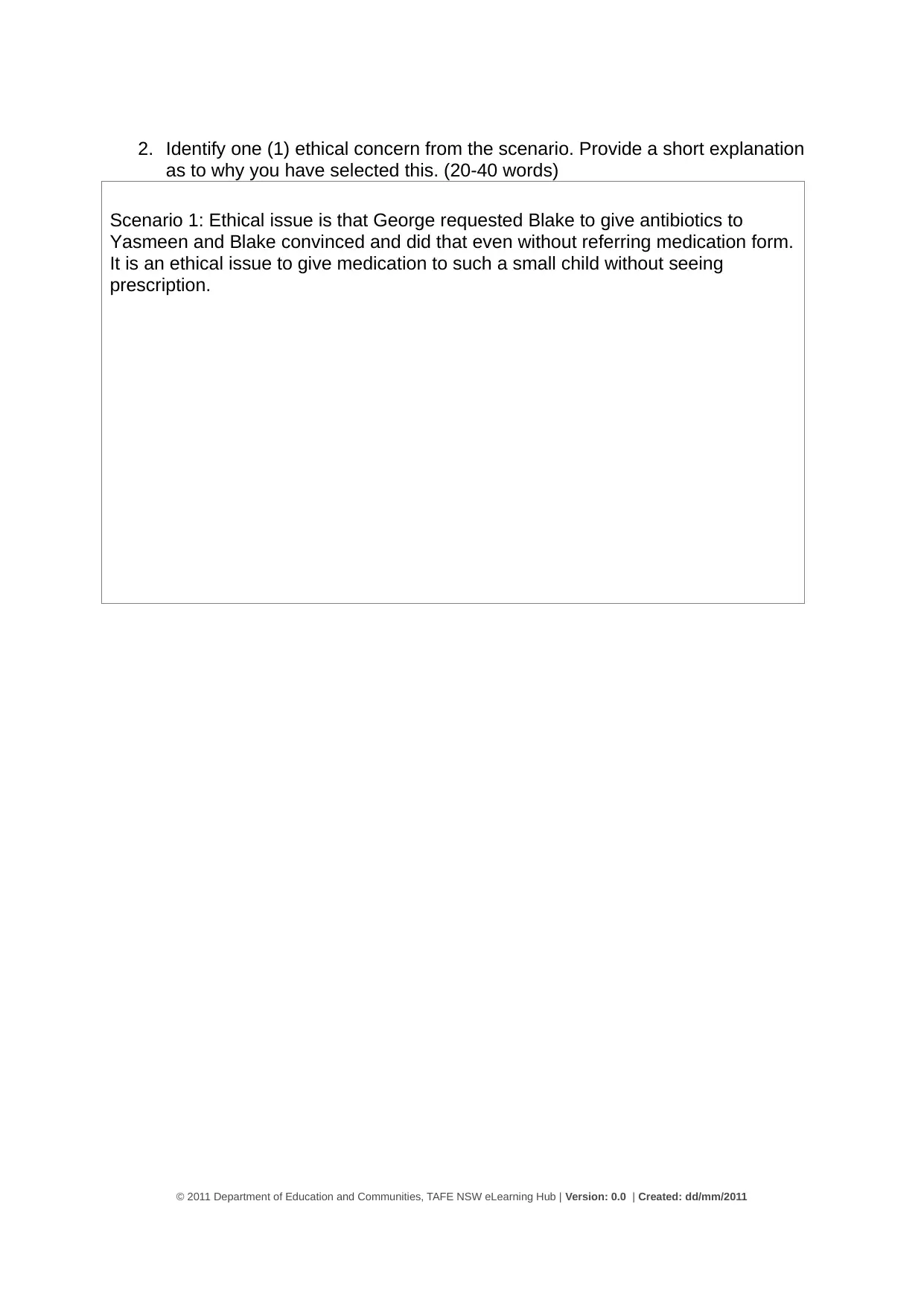
2. Identify one (1) ethical concern from the scenario. Provide a short explanation
as to why you have selected this. (20-40 words)
Scenario 1: Ethical issue is that George requested Blake to give antibiotics to
Yasmeen and Blake convinced and did that even without referring medication form.
It is an ethical issue to give medication to such a small child without seeing
prescription.
© 2011 Department of Education and Communities, TAFE NSW eLearning Hub | Version: 0.0 | Created: dd/mm/2011
as to why you have selected this. (20-40 words)
Scenario 1: Ethical issue is that George requested Blake to give antibiotics to
Yasmeen and Blake convinced and did that even without referring medication form.
It is an ethical issue to give medication to such a small child without seeing
prescription.
© 2011 Department of Education and Communities, TAFE NSW eLearning Hub | Version: 0.0 | Created: dd/mm/2011
Paraphrase This Document
Need a fresh take? Get an instant paraphrase of this document with our AI Paraphraser
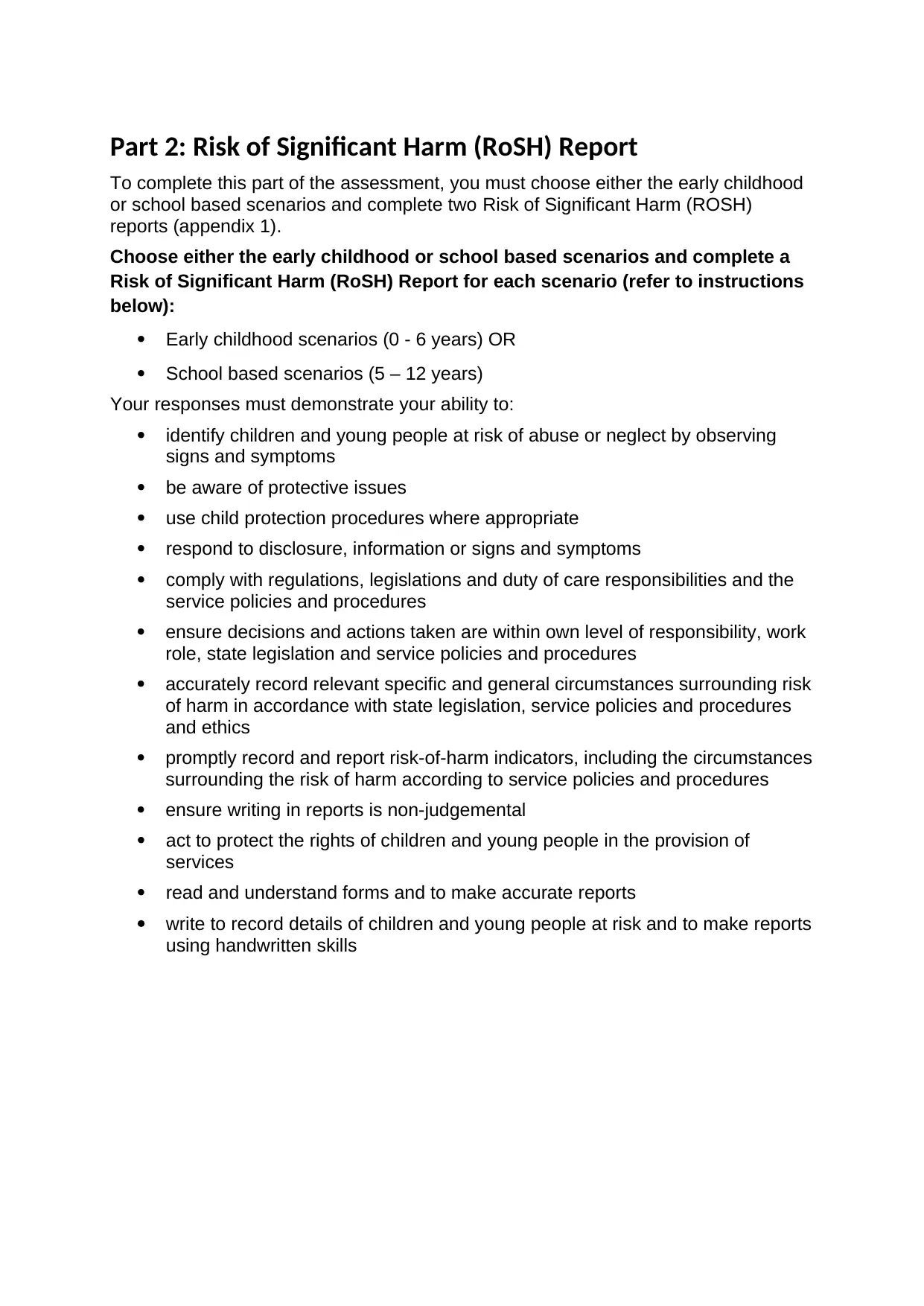
Part 2: Risk of Significant Harm (RoSH) Report
To complete this part of the assessment, you must choose either the early childhood
or school based scenarios and complete two Risk of Significant Harm (ROSH)
reports (appendix 1).
Choose either the early childhood or school based scenarios and complete a
Risk of Significant Harm (RoSH) Report for each scenario (refer to instructions
below):
Early childhood scenarios (0 - 6 years) OR
School based scenarios (5 – 12 years)
Your responses must demonstrate your ability to:
identify children and young people at risk of abuse or neglect by observing
signs and symptoms
be aware of protective issues
use child protection procedures where appropriate
respond to disclosure, information or signs and symptoms
comply with regulations, legislations and duty of care responsibilities and the
service policies and procedures
ensure decisions and actions taken are within own level of responsibility, work
role, state legislation and service policies and procedures
accurately record relevant specific and general circumstances surrounding risk
of harm in accordance with state legislation, service policies and procedures
and ethics
promptly record and report risk-of-harm indicators, including the circumstances
surrounding the risk of harm according to service policies and procedures
ensure writing in reports is non-judgemental
act to protect the rights of children and young people in the provision of
services
read and understand forms and to make accurate reports
write to record details of children and young people at risk and to make reports
using handwritten skills
To complete this part of the assessment, you must choose either the early childhood
or school based scenarios and complete two Risk of Significant Harm (ROSH)
reports (appendix 1).
Choose either the early childhood or school based scenarios and complete a
Risk of Significant Harm (RoSH) Report for each scenario (refer to instructions
below):
Early childhood scenarios (0 - 6 years) OR
School based scenarios (5 – 12 years)
Your responses must demonstrate your ability to:
identify children and young people at risk of abuse or neglect by observing
signs and symptoms
be aware of protective issues
use child protection procedures where appropriate
respond to disclosure, information or signs and symptoms
comply with regulations, legislations and duty of care responsibilities and the
service policies and procedures
ensure decisions and actions taken are within own level of responsibility, work
role, state legislation and service policies and procedures
accurately record relevant specific and general circumstances surrounding risk
of harm in accordance with state legislation, service policies and procedures
and ethics
promptly record and report risk-of-harm indicators, including the circumstances
surrounding the risk of harm according to service policies and procedures
ensure writing in reports is non-judgemental
act to protect the rights of children and young people in the provision of
services
read and understand forms and to make accurate reports
write to record details of children and young people at risk and to make reports
using handwritten skills
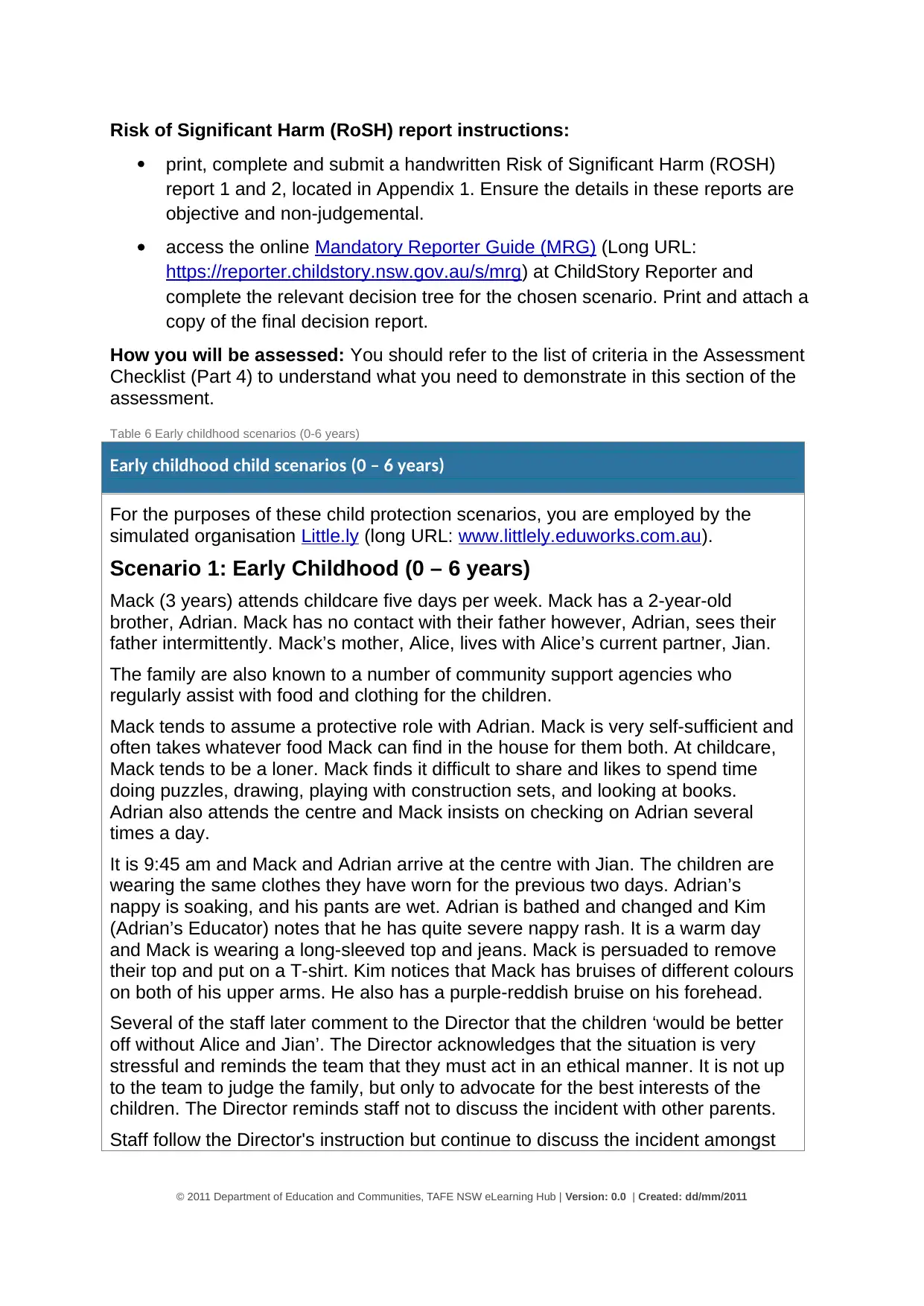
Risk of Significant Harm (RoSH) report instructions:
print, complete and submit a handwritten Risk of Significant Harm (ROSH)
report 1 and 2, located in Appendix 1. Ensure the details in these reports are
objective and non-judgemental.
access the online Mandatory Reporter Guide (MRG) (Long URL:
https://reporter.childstory.nsw.gov.au/s/mrg) at ChildStory Reporter and
complete the relevant decision tree for the chosen scenario. Print and attach a
copy of the final decision report.
How you will be assessed: You should refer to the list of criteria in the Assessment
Checklist (Part 4) to understand what you need to demonstrate in this section of the
assessment.
Table 6 Early childhood scenarios (0-6 years)
Early childhood child scenarios (0 – 6 years)
For the purposes of these child protection scenarios, you are employed by the
simulated organisation Little.ly (long URL: www.littlely.eduworks.com.au).
Scenario 1: Early Childhood (0 – 6 years)
Mack (3 years) attends childcare five days per week. Mack has a 2-year-old
brother, Adrian. Mack has no contact with their father however, Adrian, sees their
father intermittently. Mack’s mother, Alice, lives with Alice’s current partner, Jian.
The family are also known to a number of community support agencies who
regularly assist with food and clothing for the children.
Mack tends to assume a protective role with Adrian. Mack is very self-sufficient and
often takes whatever food Mack can find in the house for them both. At childcare,
Mack tends to be a loner. Mack finds it difficult to share and likes to spend time
doing puzzles, drawing, playing with construction sets, and looking at books.
Adrian also attends the centre and Mack insists on checking on Adrian several
times a day.
It is 9:45 am and Mack and Adrian arrive at the centre with Jian. The children are
wearing the same clothes they have worn for the previous two days. Adrian’s
nappy is soaking, and his pants are wet. Adrian is bathed and changed and Kim
(Adrian’s Educator) notes that he has quite severe nappy rash. It is a warm day
and Mack is wearing a long-sleeved top and jeans. Mack is persuaded to remove
their top and put on a T-shirt. Kim notices that Mack has bruises of different colours
on both of his upper arms. He also has a purple-reddish bruise on his forehead.
Several of the staff later comment to the Director that the children ‘would be better
off without Alice and Jian’. The Director acknowledges that the situation is very
stressful and reminds the team that they must act in an ethical manner. It is not up
to the team to judge the family, but only to advocate for the best interests of the
children. The Director reminds staff not to discuss the incident with other parents.
Staff follow the Director's instruction but continue to discuss the incident amongst
© 2011 Department of Education and Communities, TAFE NSW eLearning Hub | Version: 0.0 | Created: dd/mm/2011
print, complete and submit a handwritten Risk of Significant Harm (ROSH)
report 1 and 2, located in Appendix 1. Ensure the details in these reports are
objective and non-judgemental.
access the online Mandatory Reporter Guide (MRG) (Long URL:
https://reporter.childstory.nsw.gov.au/s/mrg) at ChildStory Reporter and
complete the relevant decision tree for the chosen scenario. Print and attach a
copy of the final decision report.
How you will be assessed: You should refer to the list of criteria in the Assessment
Checklist (Part 4) to understand what you need to demonstrate in this section of the
assessment.
Table 6 Early childhood scenarios (0-6 years)
Early childhood child scenarios (0 – 6 years)
For the purposes of these child protection scenarios, you are employed by the
simulated organisation Little.ly (long URL: www.littlely.eduworks.com.au).
Scenario 1: Early Childhood (0 – 6 years)
Mack (3 years) attends childcare five days per week. Mack has a 2-year-old
brother, Adrian. Mack has no contact with their father however, Adrian, sees their
father intermittently. Mack’s mother, Alice, lives with Alice’s current partner, Jian.
The family are also known to a number of community support agencies who
regularly assist with food and clothing for the children.
Mack tends to assume a protective role with Adrian. Mack is very self-sufficient and
often takes whatever food Mack can find in the house for them both. At childcare,
Mack tends to be a loner. Mack finds it difficult to share and likes to spend time
doing puzzles, drawing, playing with construction sets, and looking at books.
Adrian also attends the centre and Mack insists on checking on Adrian several
times a day.
It is 9:45 am and Mack and Adrian arrive at the centre with Jian. The children are
wearing the same clothes they have worn for the previous two days. Adrian’s
nappy is soaking, and his pants are wet. Adrian is bathed and changed and Kim
(Adrian’s Educator) notes that he has quite severe nappy rash. It is a warm day
and Mack is wearing a long-sleeved top and jeans. Mack is persuaded to remove
their top and put on a T-shirt. Kim notices that Mack has bruises of different colours
on both of his upper arms. He also has a purple-reddish bruise on his forehead.
Several of the staff later comment to the Director that the children ‘would be better
off without Alice and Jian’. The Director acknowledges that the situation is very
stressful and reminds the team that they must act in an ethical manner. It is not up
to the team to judge the family, but only to advocate for the best interests of the
children. The Director reminds staff not to discuss the incident with other parents.
Staff follow the Director's instruction but continue to discuss the incident amongst
© 2011 Department of Education and Communities, TAFE NSW eLearning Hub | Version: 0.0 | Created: dd/mm/2011
⊘ This is a preview!⊘
Do you want full access?
Subscribe today to unlock all pages.

Trusted by 1+ million students worldwide
1 out of 24
Related Documents
Your All-in-One AI-Powered Toolkit for Academic Success.
+13062052269
info@desklib.com
Available 24*7 on WhatsApp / Email
![[object Object]](/_next/static/media/star-bottom.7253800d.svg)
Unlock your academic potential
Copyright © 2020–2025 A2Z Services. All Rights Reserved. Developed and managed by ZUCOL.





